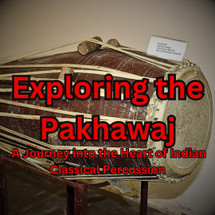Posted by Steve Head on 25th Aug 2024
Exploring the Pakhawaj: A Journey into the Heart of Indian Classical Percussion
As a drum builder and percussion enthusiast, I find myself constantly drawn to the rich tapestry of rhythms and instruments from around the world. One such instrument that has captured my fascination is the Pakhawaj—an ancient Indian drum that has played a pivotal role in shaping the music and culture of the Indian subcontinent. With its deep, resonant tones and complex rhythmic patterns, the Pakhawaj is not just an instrument but a bridge to centuries-old traditions that continue to thrive in modern times.
In this blog post, I’ll take you through the history, construction, playing techniques, and cultural significance of the Pakhawaj, as well as its influence on contemporary music.
The Origins and History of the Pakhawaj
The Pakhawaj is a barrel-shaped, double-headed drum that has been a cornerstone of Indian classical music for centuries. It is closely associated with the dhrupad style of Hindustani classical music, which is one of the oldest and most profound forms of Indian classical music. The origins of the Pakhawaj can be traced back to the ancient mridangam, a drum that is still widely used in South Indian Carnatic music today.
Over time, as musical styles evolved in North India, the Pakhawaj emerged as the dominant percussion instrument in the dhrupad genre. Its deep, bass-heavy sound and ability to produce intricate rhythmic patterns made it an essential accompaniment to the vocal and instrumental compositions of dhrupad.
The Pakhawaj has also had a significant influence on the development of other Indian drums, most notably the tabla. The tabla, which is now the most popular percussion instrument in Hindustani classical music, is believed to have evolved from the Pakhawaj. This evolution likely occurred when musicians sought a drum that could produce a wider range of tones and was more portable.
For a more in-depth exploration of the Pakhawaj’s history and its role in Indian classical music, I recommend checking out this Kopf Percussion instruments to be an excellent resource.
The Cultural Significance of the Pakhawaj
The Pakhawaj holds a special place in Indian culture, particularly in the dhrupad tradition, where it serves as the primary percussion instrument. Dhrupad is a highly spiritual and meditative form of music, often performed in temples and during religious ceremonies. The Pakhawaj’s deep, resonant tones are believed to invoke a sense of devotion and reverence, making it an integral part of the dhrupad experience.
In addition to its role in dhrupad, the Pakhawaj is also used in other classical dance forms such as Kathak and Odissi, where it provides the rhythmic foundation for the dancers. The drum’s ability to produce a wide range of sounds makes it ideal for accompanying the complex footwork and intricate movements of these dance forms.
The Pakhawaj’s cultural significance extends beyond its musical applications. It is often regarded as a symbol of tradition and heritage, representing the continuity of Indian classical music through the ages. The drum is also a testament to the craftsmanship and artistry of Indian instrument makers, who continue to preserve and pass down the techniques of Pakhawaj construction from generation to generation.
Building a Pakhawaj: Materials and Techniques
As a drum builder, I’m always intrigued by the craftsmanship that goes into creating traditional instruments like the Pakhawaj. The process of building a Pakhawaj is both an art and a science, requiring a deep understanding of materials and acoustics.
The body of the Pakhawaj is typically made from a single block of wood, usually teak or rosewood, which is carefully hollowed out to form the barrel shape. The choice of wood is crucial, as it affects the drum’s resonance and tonal quality. The drumheads are made from layers of animal hide, usually goat or buffalo skin, which are stretched tightly over the ends of the drum and secured with leather straps.
One of the most distinctive features of the Pakhawaj is the use of siyahi, a black tuning paste applied to the center of the drumheads. The siyahi is made from a mixture of rice paste, iron filings, and other secret ingredients, and it plays a vital role in tuning the drum and producing its characteristic sound.
The tuning of the Pakhawaj is achieved by tightening or loosening the leather straps and adjusting the siyahi. This process requires a skilled hand, as even slight adjustments can significantly impact the drum’s pitch and tone.
Building a Pakhawaj is a labor-intensive process that requires patience, precision, and a deep respect for tradition. It’s a reminder of the intricate craftsmanship involved in creating percussion instruments, and it’s something that continues to inspire me in my own work.
The Pakhawaj in Modern Music
While the Pakhawaj is deeply rooted in Indian classical music, it has also found a place in modern and fusion music. Musicians across genres have embraced the Pakhawaj for its deep, resonant tones and rhythmic complexity, incorporating it into a variety of musical styles.
In contemporary music, the Pakhawaj is often used in fusion ensembles, where it is combined with other Indian and Western instruments to create a rich, layered sound. The drum’s versatility makes it an ideal instrument for exploring new rhythmic possibilities and pushing the boundaries of traditional music.
Additionally, the Pakhawaj has been featured in film scores, world music projects, and experimental compositions, further demonstrating its adaptability and enduring appeal. Musicians and composers continue to explore the Pakhawaj’s potential, bringing its ancient rhythms to new audiences around the world.
Final Thoughts
The Pakhawaj is more than just a drum; it is a vessel of tradition, culture, and spirituality. Its deep, resonant tones have been the heartbeat of Indian classical music for centuries, and its influence continues to be felt in modern music. Whether you’re a percussionist, a music enthusiast, or simply someone who appreciates the beauty of traditional instruments, the Pakhawaj offers a rich and rewarding musical experience.
As I continue to explore and build percussion instruments, I am constantly inspired by the history and craftsmanship of instruments like the Pakhawaj. It serves as a reminder of the deep connections between music, culture, and tradition, and it is a testament to the enduring power of rhythm.
If you’re interested in learning more about traditional percussion instruments or exploring new sounds, I encourage you to dive deeper into the world of the Pakhawaj and other instruments. Visit this link for more information:
https://www.india-instruments.com/encyclopedia-pakhawaj.html
Whether you’re playing it, building it, or simply listening, the Pakhawaj is sure to captivate and inspire.
Thumbnail Image Credit to:

